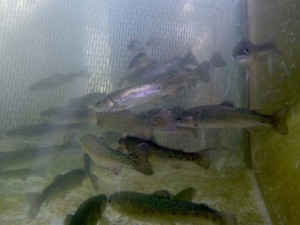More than 10,000 acres of scenic meadows, forests and trout streams in the Sierra Nevada 10 miles west of Lake Tahoe have been preserved in a deal in which environmentalists hope to prove that thinning out overgrown forests can increase California’s water supply.
The Northern Sierra Partnership, an environmental group based in Palo Alto and founded by longtime Silicon Valley leaders Jim and Becky Morgan, joined with the Nature Conservancy and the American River Conservancy to buy the land for $10.1 million from Simorg West Forests, a timber company based in Atlanta.
The deal, which closed Aug. 5, preserves a landscape south of Interstate 80 in Placer County adjacent to Granite Chief Wilderness in the Tahoe National Forest. The land contains more than 20 miles of blue ribbon trout streams.
Home to black bears, mountain lions, deer, songbirds and other wildlife, the remote property also includes the headwaters of two of California’s popular whitewater rafting rivers, the North and Middle forks of the American River.
“There are forests and meadows, and granite outcroppings,” said David Edelson, Sierra Nevada director for the Nature Conservancy. “There are terrific views looking down the American River watershed and toward the Granite Chief Wilderness.”
For years, loggers turned the property’s evergreen forests into wooden crates for Central Valley fruits and vegetables. Now the environmental groups plan to remove old logging roads and restore the landscape.
But more significant, the purchase could change how California, now suffering through the fourth year of a historic drought, manages its Sierra Nevada forests in ways that might provide more water to cities, farms and the environment.
Many Sierra Nevada forests, including the ponderosa pine, white fir and Jeffrey pine forests on this property, burned roughly every 10 years in lightning-sparked fires before California became a state in 1850. Those natural fires thinned out dead trees and brush.
But starting roughly 100 years ago, the U.S. Forest Service and other agencies began putting out the fires, often to protect communities that had sprung up through the mountains. As a result, the forests grew thicker. Now, across millions of acres of the Sierra, around Lake Tahoe and in other parts of the West, some evergreen forests have five times or more trees per acre as they would naturally.
The trees are small, spindly and often prone to disease and beetles.
UC Merced and UC Berkeley scientists have done research indicating that if these forests are thinned it could increase the amount of water flowing from the Sierra Nevada into streams, rivers, the Sacramento-San Joaquin River Delta and San Francisco Bay.
“We’re trying to keep the trees in check so the forest is in a more sustainable condition,” said Roger Bales, a UC Merced engineering professor who directs the university’s Sierra Nevada Research Institute. “One of the benefits is that you get more water.”
The Sierra Nevada provides 40 percent or more of California’s water supply through snow and rain.
More at MercuryNews.com >>>

